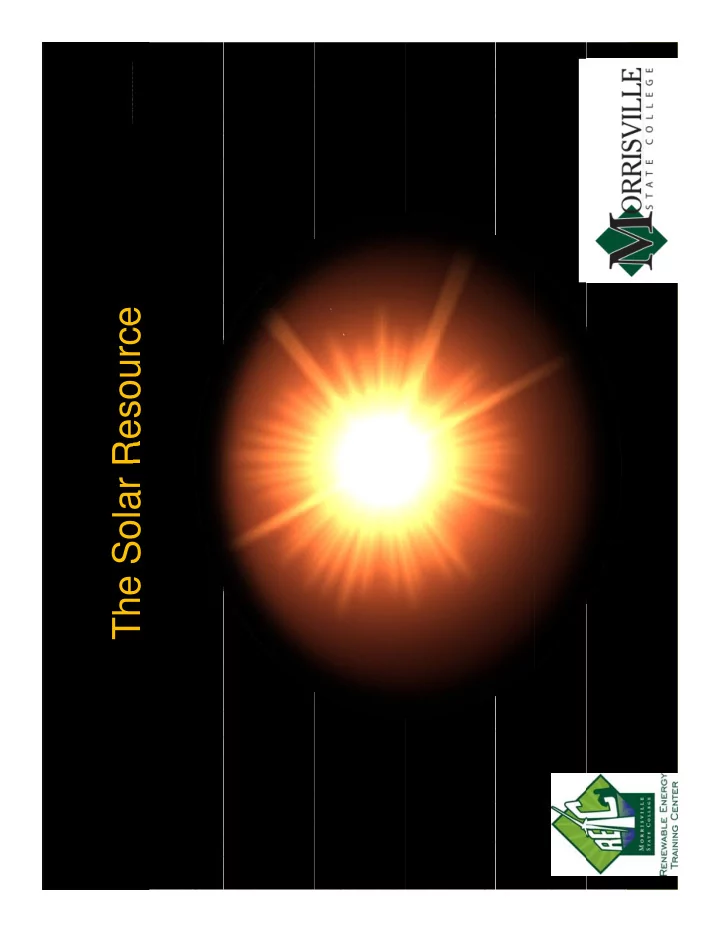

The Solar Resource The Solar Resource
Overview • Overview of the solar resource in the U.S. • Features impacting solar irradiance » Latitude, cloud cover, seasonality , , y • Converting power to energy • Tools to measure solar energy and shading • Tools to measure solar energy and shading • An overview of solar energy systems 3/30/2009 http://retc.morrisville.edu 2
Solar PV World PV market in 2007, 2826 MW total Rest of EU 6% Rest of world world 8% USA 8% Germany Japan 47% 8% Spain 23% 23% Solarbuzz LLC. 3/30/2009 http://retc.morrisville.edu 3
So Germany must be sunny, right? 3/30/2009 http://retc.morrisville.edu 4
Measuring the solar resource • Magnetic declination • Solar pathways • Solar math (power to energy) Solar math (power to energy) • Latitude and curvature • Air currents Ai t 3/30/2009 http://retc.morrisville.edu 5
What impacts solar gain each day? Latitude (winter solstice) 3/30/2009 http://retc.morrisville.edu 6 http://dcweather.blogspot.com/2005/12/winter-time-in-washington_21.html
Sun Path – New York Summer Solstice Equinox Winter Solstice e So s ce E N S W This angle should be equal to your latitude 3/30/2009 http://retc.morrisville.edu 7
Magnetic Declination http://sos.noaa.gov/images/Land/magnetic_declination.jpg 3/30/2009 http://retc.morrisville.edu 8
True south and declination our.jpg s/us_d_conto geomag/icons c.noaa.gov/g p://www.ngdc htt 3/30/2009 http://retc.morrisville.edu 9
Declination corrections True North Magnetic North 12 ° 48’ W 12 48 W http://www.ngdc.noaa.gov/geomagmodels/Declination.jsp True South True South 4/3/2009 http://retc.morrisville.edu 10
Solar Angles by month in Morrisville 3/30/2009 http://retc.morrisville.edu 11
What impacts solar gain each day? • Latitude m.jpg /lecture_02/04m ewcrop/tropical/ .purdue.edu/ne http://www.hort. h 3/30/2009 http://retc.morrisville.edu 12
Morrisville’s Solar Resource Month Mean W/m 2 /day kWh/m 2 /day January January 63 8 63.8 February 98.8 March 140.9 April 182.1 May 220.5 June 231.5 July 224.2 August 203.0 September September 159 6 159.6 October 101.0 November 59.3 December 44.7 3/30/2009 http://retc.morrisville.edu 13
Morrisville’s Solar Resource Month Mean W/m 2 /day kWh/m 2 /day kWh/m 2 /day = January January 63 8 63.8 February 98.8 March 140.9 April 182.1 May 220.5 June 231.5 July 224.2 August 203.0 September September 159 6 159.6 October 101.0 November 59.3 December 44.7 3/30/2009 http://retc.morrisville.edu 14
Morrisville’s Solar Resource Month Mean W/m 2 /day kWh/m 2 /day kWh/m 2 /day = January January 63 8 63.8 1 5 1.5 24 24 Hrs H 1 1 kWh kWh W/m 2 /day February 98.8 2.4 Day 1000 Wh March 140.9 3.4 April 182.1 4.4 May 220.5 5.3 Yearly mean power? June 231.5 5.6 • 144.1 W/m 2 /day 2 / / July 224.2 5.4 August 203.0 4.9 Yearly mean energy? y gy September September 159 6 159.6 3.8 3 8 • 3.5 kWh/m 2 /day October 101.0 2.4 November 59.3 1.4 December 44.7 1.1 3/30/2009 http://retc.morrisville.edu 15
Solar energy throughout the year MSC weather station data 6 5 4 Wh/m2/day 3 kW 2 1 1 0 Jan Feb Mar Apr May Jun Jul Aug Sep Oct Nov Dec Solar Energy 3/30/2009 http://retc.morrisville.edu 16
How does central NY compare? • Average of solar energy throughout the year is 3.5 kWh/m 2 /day. » This is 1277.5 kWh/m 2 /year (365 days * 3.5 per day) » Albany has a daily average of 4.3 kWh/m 2 /day (1569.5 kWh/m 2 /year) » San Diego has 7.3 kWh/m 2 /day (2664.5 kWh/m 2 /year) 2 / kWh/ ) 3/30/2009 http://retc.morrisville.edu 17
Solar energy 3/30/2009 http://retc.morrisville.edu 18
Cloud cover 3/30/2009 http://retc.morrisville.edu 19 http://www.colorado.edu/geography/class_homepages/geog_3251_sum08/07_rainshadow.jpg
Air Cells Low pressure ey.JPG biol/desert/hadle earlham.edu/~b Rain Forests (cloudy) Deserts High pressure High pressure http://www.e ( (sunny) ) 3/30/2009 http://retc.morrisville.edu 20
Global Solar Energy sa.gov ww.larc.na //earth-ww http: 3/30/2009 http://retc.morrisville.edu 21
Solar energy systems • If you assume that systems costs are comparable in NY and southern California, which location has more expensive solar energy? 3/30/2009 http://retc.morrisville.edu 22
Estimating the Solar Resource 3/30/2009 http://retc.morrisville.edu 23
Estimating the Solar Resource 3/30/2009 http://retc.morrisville.edu 24
Estimating the Solar Resource S W W E 3/30/2009 http://retc.morrisville.edu 25
Estimating the Solar Resource June (lowest line): 1+1+2+2+3 = 9% July (next up): 1+1+2+3+3 = 10% May: 1+1+2+3+3 = 10% y % August: 1+1+2+2+3 = 9% April: 1+2+2+3 = 8% September: 1+2+2 = 5% October: 1% 3/30/2009 http://retc.morrisville.edu 26
Estimating the Solar Resource Percentage Daily Monthly Month kWh/m 2 /day Lost Energy Energy January J 1 5 1.5 0 0 1 5 1.5 46 5 46.5 February 2.4 0 2.4 67.2 March 3.4 0 3.4 105.4 April April 4.4 4 4 8% 8% 4 048 4.048 121 44 121.44 May 5.3 10% 4.77 147.87 June 5.6 9% 5.096 152.88 July July 5 4 5.4 10% 10% 4 86 4.86 150 66 150.66 August 4.9 9% 4.459 138.229 September 3.8 5% 3.61 108.3 October October 2.4 2.4 1% 1% 2.376 2.376 73.656 73.656 November 1.4 0 1.4 42 December 1.1 0 1.1 34.1 Total annual energy 1188.24 3/30/2009 http://retc.morrisville.edu 27
Solar energy systems 3/30/2009 http://retc.morrisville.edu 28
Photovoltaics 3/30/2009 http://retc.morrisville.edu 29
Solar Thermal Electricity P Parabolic mirrors b li i 3/30/2009 http://retc.morrisville.edu 30
Solar Hot Water Images courtesy of John Siegenthaler Domestic solar hot water system • Flat plate collector (low temp) Fl l ll (l ) • Evacuated tubes (higher temp) • Solar hot water tank with heat exchanger 3/30/2009 http://retc.morrisville.edu 31
Passive Solar Heating Thermal mass Conifers to the north Large windows facing south Small windows to north 3/30/2009 http://retc.morrisville.edu 32
Summary • New York has an adequate solar resource for solar PV, solar hot water, and passive solar homes • Solar power can be easily converted to solar energy (and we can account for shading) • Incoming solar energy is affected by many factors such as latitude, cloud cover, and time of year • Many systems can take advantage of solar energy 3/30/2009 http://retc.morrisville.edu 33
Contact Information Phil Hofmeyer, Ph.D. A i t Assistant Professor t P f Ph: 315 ‐ 684 ‐ 6515 Email: hofmeypv@morrisville.edu Web: http://people.morrisville.edu/~hofmeypv/ Ben Ballard Ph D Ben Ballard, Ph.D. Director, RETC Assistant Professor Assistant Professor Ph: 315 ‐ 684 ‐ 6780 Email: ballarbd@morrisville.edu Web: http://people morrisville edu/~ballarbd/ Web: http://people.morrisville.edu/~ballarbd/ http://retc.morrisville.edu
Recommend
More recommend